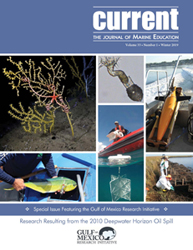Category Archives: Lesson Plans

Plankton are a very important part of the food chain in the northeastern Gulf of Mexico drift through the ocean carried by currents. Although plankton can’t control their movements against the current, they are able to maintain neutral buoyancy by increasing their surface area-to-volume ratio as well as by producing and releasing lipids (fats). In Read More
The Ecosystem Impacts of Oil and Gas Inputs to the Gulf (ECOGIG) consortium worked with the Georgia Institute of Technology Center for Education Integrating Science, Mathematics, and Computing (CEISMC) to develop and test three middle school teaching modules. The modules developed are:– (7th Grade) Life Science – Data Visualization: “Under the Sea” Deep Sea Ecosystems Read More
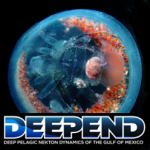
“The BP Oil Spill and Its Aftermath – Exploring Through Art” is a middle and high school level lesson plan that utilizes art to explore oil spill science. During the lesson, students will engage in discussions about the Deepwater Horizon oil spill, reflect on and create art related to the spill, and explore ongoing research Read More

This fun and creative lesson plan teaches students how researchers use oceanographic instruments called drifters to study ocean currents and then has them design and build a drifter of their own. The lesson typically spans five class periods (three for building, one for presentation, and one for testing). The lesson plan includes background information, a Read More

This lesson plan teaches middle and high school students how ocean currents transport debris, spilled oil, and other pollutants through the ocean environment. The lesson uses real data collected during the Biscayne Bay Drift Card Study (Bay Drift), a citizen science study that used Consortium for Advanced Research on Transport of Hydrocarbon in the Environment Read More
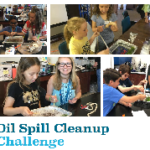
The Oil Spill Cleanup Challenge lesson plan and activity are designed to get students thinking about oil in the ocean, especially the 2010 Deepwater Horizon disaster and the challenge of oil spill response. The activity is appropriate for a wide range of ages and uses a water-filled tray to represent the Gulf of Mexico and Read More

The Adventures of Zack and Molly is a four-part animated short video series that tells the story of a young man, Zack, who is more interested in the small world of his smartphone than the larger world around him. Zack’s online request for a roommate is answered by Molly, a tech-savvy Dumbo Octopus on a Read More
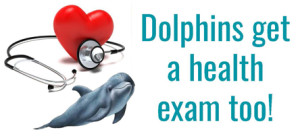
Previous research has shown that dolphins in regions affected by the Deepwater Horizon oil spill have poor body condition, reproductive failure, lung disease, and adrenal system injury. The Consortium for Advanced Research on Marine Mammal Health Assessment (CARMMHA) outreach plan was shaped by the Gulf of Mexico Research Initiative’s (GoMRI) mission to improve society’s ability Read More

Free, downloadable classroom materials covering topics ranging from bioluminescence, marine environments, hydrothermal vents, food webs and Light in the deep sea – including curricula and experiment instructions. Grades 9th – 12th Bioluminescence Candy Chemosynthesis Hydrothermal Vent Food Web Oceanographic Terms and Equipment ROV in a Bag Water-down Topographic Map Marine Environments Teaching Module Light in Read More

Free, downloadable classroom materials covering topics ranging from the BP Oil Spill and its aftermath explored through art, marine environments, hydrothermal vents, food webs and light in the deep sea – including curricula and experiment instructions! Grades 6th – 8th Hydrothermal Vent Food Web Light at the Bottom of the Deep, Dark Ocean? Marine Environments Read More
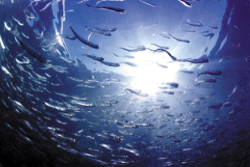
Free, downloadable classroom materials covering topics ranging from bioluminescence to hydrothermal vent food webs and include curricula, experiment instructions, and coloring sheets! Taking Science Deeper Activities Grades K – 5 Book 1: Introduction to the Deep Sea Book 2: Deep-Sea Animals Book 3: Hagfish Day! Book 4: Ocean Currents and Pollution Awareness Coloring Sheet – Read More
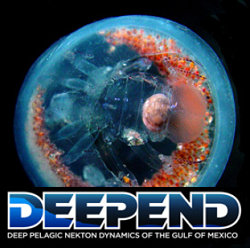
The new module Nature of Science targets grades 6-12 and utilizes consortium research data to clearly describe the scientific method, including what is science, how is science conducted, and how is science communicated. The full 45-page module is available for download from the DEEPEND website and here on the GoMRI Education site.

The module is the fourth in a series of marine environment-focused teaching and learning modules developed by the consortium for grades 6 – 12. This module focuses on navigating marine environments, particularly historical and current human navigation and animal navigation. The module is available for download here. This module was developed by the DEEPEND (Deep-Pelagic Nekton Read More

The Deep-Pelagic Nekton Dynamics (DEEPEND) Consortium has created lesson plans for “Taking Science Deeper” Activities. Book 1: Introduction to the Deep Sea Book 2: Deep-Sea Animals Book 3: Hagfish Day! Book 4: Ocean Currents and Pollution Awareness For additional educational materials from DEEPEND, click here.
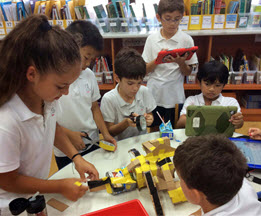
Communicating oil spill research is essential to improve society’s understanding about spills and their ability to respond to and mitigate them. The Gulf of Mexico Research Initiative (GoMRI) has been funding spill-related research since 2010. Here are ten outstanding education products and resources that GoMRI and its science community have developed to share what they Read More

Story posted by Nina Pruzinsky on DEEPEND’s BLOG On Friday, March 4, 2016, Mike Novotny and Nina Pruzinsky visited Mr. Kyle Lendick’s 6th grade Marine Science classes at New River Middle School. The three classes spent several weeks completing Deep-Pelagic Nekton Dynamics (DEEPEND)’s grade 6-8 lesson plans (found in the Education/Outreach section under Education, Resources, Read More
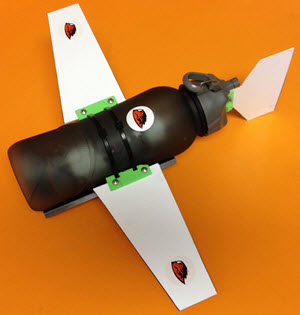
Twenty teachers turn water bottles into mini SeaGliders The research and science behind projects like Littoral Acoustic Demonstration Center – Gulf Ecological Monitoring and Modeling (LADC-GEMM) can often seem high-brow, inaccessible, and even confusing. So, one of the ways the LADC-GEMM project aims to demystify ocean science is by using the popularity of robotic ocean gliders Read More

Screenscope, Inc. has completed production of three Dispatches from the Gulf documentary films, which features scientists working to better understand the effects of the Deepwater Horizon oil spill. Dispatches from the Gulf is part of the Journey to Planet Earth series and is narrated by Matt Damon. All three films and corresponding educational materials are Read More

The lesson plans below are related to oil spill research. Some of these lesson plans are general, and it may be necessary to modify the activities for specific grade levels. Coral de las aguas profundas ‘Bichos una Aventura en Miniatura’ Golfo de Mexico EdiciÓn Modelando la Costa Extracción de Aceite Cámara Gusano “Wormcam” Alerta! Emergencia Read More

A team of scientists and education staff developed a user-friendly curriculum to help students make connections between the theoretical nature of science and real world applications. This education tool uses application-based science conducted by the Deep-C Consortium to improve Gulf of Mexico literacy and addresses issues such as environmental disasters, their impacts on ocean ecosystems, Read More

The Coastal Waters Consortium’s Education and Outreach program translates research investigating the effects of the Deepwater Horizon Oil Spill on coastal ecosystems into understandable formats for all levels of society. The program facilitates interactions of students, teachers, adults and other community members with CWC Scientists through the following initiatives and programs: K-12 Education Teacher Education Read More
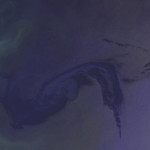
Synthetic aperture radar (SAR) is now commonly used for operational oil spill monitoring. During major spills, SAR data from different satellites give an overview of the areas affected and provide information on the direction in which surface oil is drifting. SAR is also used to monitor illegal discharges from ship traffic or offshore operations. In Read More

Many times, people think about the environmental impacts of an oil spill and the main organisms (impacted) that come to mind are marine mammals, crustaceans, fish, birds, and even mollusks. Insects are often forgotten, but some species are closely associated to soil and plant life; therefore, some insects are of high ecological value. Some insects Read More
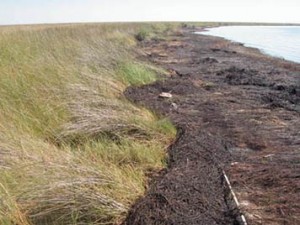
Coastal wetland vegetation is essential to the coastal area because it provides a barrier for the local community, a nursery habitat for juvenile organisms, and a highly productive environment for the marine life. This form of vegetation has a very high potential to come in contact with pollution, originating from inshore or offshore sources, because Read More
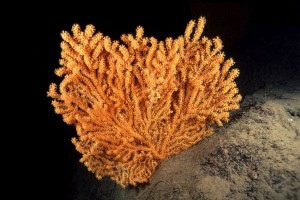
Deepwater coral reefs, aptly known as cold-water coral reefs, can be formed by the carbon created when bacteria biodegrade oil from natural seeps nearby. Oil spills can be easily devastating to coral reefs, ranging from the reefs at the surface of the water, directly subsurface, and even cold-water corals.

